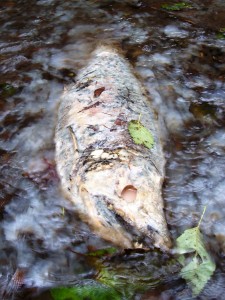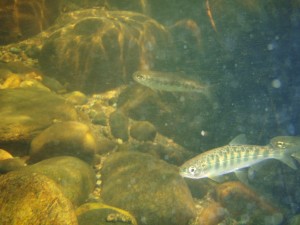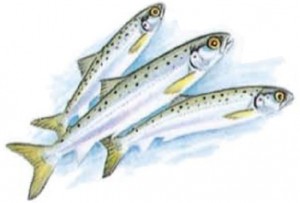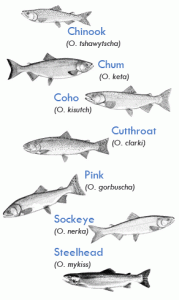The question has often been asked, what came first the salmon or the egg?
This section strives to answer that question, although it will somewhat biasly begin with the egg.
Stage 1: The salmon begins life as an egg. The eggs in the photo above are called eyed eggs because the eye spot is visible. This is also an indicator that the egg is viable, meaning that it was fertilized and is growing life. The amount of incubation time is temperature dependent, with higher temperatures corresponding with shorter incubation time.
Length of time spent as an Egg:
Chum: 16 weeks/ 4 months
Sockeye: 6 to 9 weeks/ 1.5 to 2.5 months
Chinook: 12 weeks/3months
Coho: 6 to 7 weeks/ 1.5 to 2 months
Pink: 18 weeks/ 4.5 months
Steelhead: 4 to 7 weeks/ 1 to 1.5 months
Cutthroat: 4 to 7.5 weeks/ 1 to 1.5 months
Stage 2: After the salmon hatches it is known as an Alevin. The Alevin does not yet have a fully formed mouth or digestive system. Instead it lives off the nutrients provided from its yolk sac.
Length of time spent as an Alvin:
Chum: 45 days/ 8 weeks
Sockeye: 21 to 35 days/ 3-5 weeks
Chinook: 14 to 21 days/ 2-3 weeks
Coho: 14 to 21 days/ 2-3 weeks
Pink: 30 to 60 days/ 4-8 weeks
Steelhead: 3 to7 days/ less than 1 week
Cutthroat: 7 to 14 days/ 1-2 weeks
Stage 3: As the Alevin’s digestive system matures the fish gradually becomes a Fry. Fry have vertical stripes on the side of their body known as parr marks. These marks are the reason why this stage is sometimes also known as the Parr stage. Fry like the Egg and Alvin live in freshwater.
Length of time spent as a Fry:
Chum: No fry stage, this species heads directly to the ocean after emerging from the gravel.
Sockeye: 1 to 2 yrs and sometimes 3 to 4 yrs
Chinook: approximately 1yr
Coho: Average 2 yrs in freshwater depending on the river system, with fish from the more northern latitudes spending more time in freshwater.
Pink: No fry stage, this species heads directly to the ocean after emerging from the gravel.
Steelhead: 1 to 4 yrs
Cutthroat: 2 to 3 yrs
Stage 4: The maturing Fry makes its way downstream to the estuary. The salmon transitions from living in freshwater to living in saltwater, through a process called osmoregulation. At the end of the transformation the salmon becomes a Smolt. Smolts loose the parr marks of the Fry and turn silvery
Length of time spent as a Smolt:
Chum: Spend several weeks very nearshore followed by several months farther out in the estuary.
Sockeye: No documented time of sockeye spending time in the estuary. It is assumed that they head straight out to sea.
Chinook: 2 to 3 months
Coho: 2 to 3 months
Pink: 4 to 5 months
Steelhead: 2 to 3 yrs and sometimes only 1 or up to 4
Cutthroat: 1yr or less (this species can spawn in freshwater more than once so an individual may make the saltwater transition more than one time in its life.)
Stage 5: The growing Smolt eventually becomes the Ocean Going Adult. The Ocean phase leaves the nearshore waters and heads to the cold, open waters off of Japan and Alaska.
Length of time spent as an Ocean Going Adult:
Chum: 2 to 5yrs
Sockeye: 1 to 4yrs
Chinook: 1 to 5 yrs
Coho: 2 to 3 yrs
Pink: 2 yrs
Steelhead: 1 to 4 yrs (may not be continual as this species can spawn in freshwater more than once)
Cutthroat: Stay near their rivers in the estuary
Stage 6: After spending 1-8 yrs (depending on species and reproductive maturity) in the ocean, salmon return to their natal streams to spawn and thus the Spawning phase. During migration salmon stop eating, and once freshwater is entered they have approximately 2 weeks left to live. Once mates are found and eggs are laid, the life cycle has officially been completed. However, there is one final phase for the Spawner.

Stage 7: When the Spawner dies its body is called a Carcass. During this stage salmon streams can become rather smelly. This Carcass, however, is super important to the overall ecosystem as well as the next generation of salmon. The Carcass provides ocean derived nutrients to the forest, the equivalent of a 10-20lbs bag of organic fertilizer per fish. This influx of nutrients helps trees and plants in the riparian zone grow. Strong healthy plants provide erosion control keeping streams dirt free. Tall trees shade the stream keeping the first 3 stages of the salmon life cycle cool. Young salmon also feed on the invertebrates that break down the carcasses of the Spawners.






